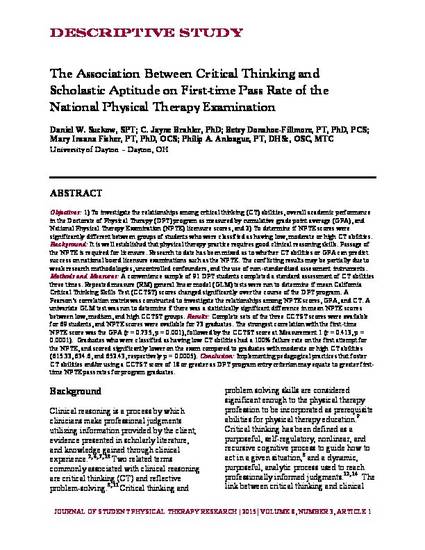
Objectives: 1) To investigate the relationships among critical thinking (CT) abilities, overall academic performance in the Doctorate of Physical Therapy (DPT) program as measured by cumulative grade point average (GPA), and National Physical Therapy Examination (NPTE) licensure scores, and 2) To determine if NPTE scores were significantly different between groups of students who were classified as having low, moderate or high CT abilities.
Background: It is well-established that physical therapy practice requires good clinical reasoning skills. Passage of the NPTE is required for licensure. Research to date has been mixed as to whether CT abilities or GPA can predict success on national board licensure examinations such as the NPTE. The conflicting results may be partially due to weak research methodologies, uncontrolled confounders, and the use of non-standardized assessment instruments.
Methods and Measures: A convenience sample of 91 DPT students completed a standard assessment of CT abilities three times. Repeated measure (RM) general linear model (GLM) tests were run to determine if mean California Critical Thinking Skills Test (CCTST) scores changed significantly over the course of the DPT program. A Pearson’s correlation matrix was constructed to investigate the relationships among NPTE scores, GPA, and CT. A univariate GLM test was run to determine if there was a statistically significant difference in mean NPTE scores between low, medium, and high CCTST groups.
Results: Complete sets of the three CCTST scores were available for 69 students, and NPTE scores were available for 73 graduates. The strongest correlation with the first-time NPTE score was the GPA (r = 0.735, p = 0.001), followed by the CCTST score at Measurement 1 (r = 0.413, p = 0.0001). Graduates who were classified as having low CT abilities had a 100% failure rate on the first attempt for the NPTE, and scored significantly lower on the exam compared to graduates with moderate or high CT abilities (615.33, 634.6, and 652.43, respectively p = 0.0005).
Conclusion: Implementing pedagogical practices that foster CT abilities and/or using a CCTST score of 18 or greater as DPT program entry criterion may equate to greater first-time NPTE pass rates for program graduates.
Available at: http://works.bepress.com/betsy_donahoe-fillmore/4/

All content used from this article must be attributed. The Journal of Student Physical Therapy Research (JSPTR) is an open-access, peer-reviewed online journal that encompasses all aspects of clinical and basic research studies related to physical therapy. Permission documentation is on file.